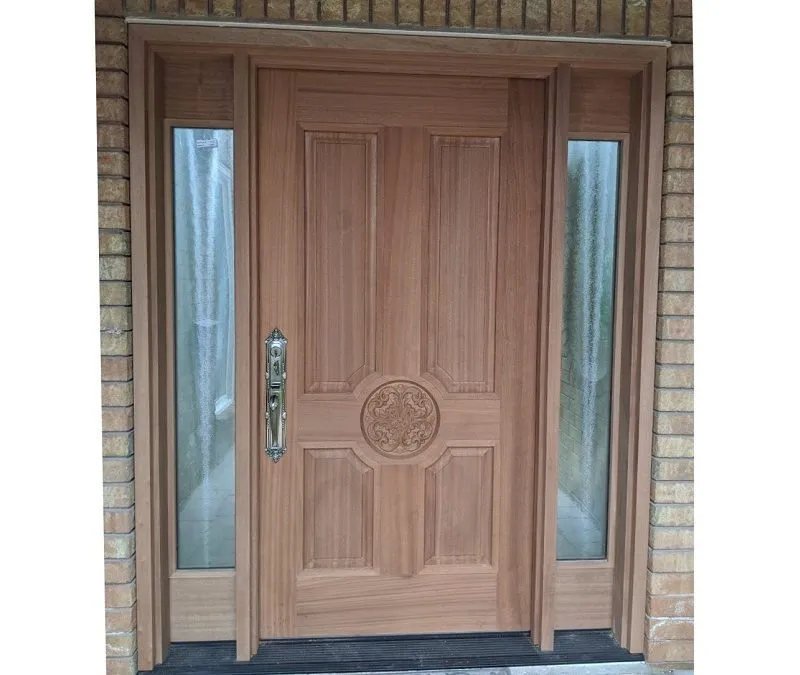If you’re planning to upgrade your home’s entryway, choosing the best wood for your exterior door is essential for long-term performance and curb appeal. There are a number of wood types out there to choose from that make strong, sturdy doors. The team of experts at Master Doors in Ontario, Canada, has collected some of the most popular choices, and explains in this article what sets these types of wood apart for long-lasting front doors.
Why Choose an Exterior Door Made Out of Wood?
Before diving into the details, we wanted to discuss some of the reasons to choose a wood exterior door over other alternatives. Firstly, a solid wood door can give your home a more sophisticated and unique look. Wood is also the most sustainable and green option when it comes to building materials and offers an unmatched beauty for luxury door manufacturing.
The Best Wood Types for Exterior Doors
1. Cedar
One of the leading wood species for weather-resistant wood front doors is cedar because it provides unique advantages like a luxuriant pine-like smell due to the resins and oil it contains. An added benefit of the fragrance is that it repels most insects, making door maintenance much easier. Also, the same oils and resins that provide cedar with its pleasant smell also enable it to withstand the elements better than other wood types.
2. Knotty Alder
Knott alder is a preferred exterior door wood by many due to its unique, knotted appearance in the wood grain. The knots are often symmetrical and can turn your exterior door into a great focal point of your home. Also, it’s versatile and can serve just as well as a strong door for a cabin in the woods, or to provide a more classic, rustic look to your modern home.
3. Mahogany
For a more antique and historical look, mahogany is the premier wood for exterior doors due to the elegance it exudes. It provides a more opulent look suited to historical homes, mansions, and even castles. Although the species originates from Brazil, many of today’s luxury homes choose this option even if it’s a slightly higher price due to the unique look it provides.
4. Oak
Last but certainly not least, oak is a tried and true wood for exterior doors that is considered one of the most beautiful hardwoods available today. It’s not commonly known, but there is a variety of oak species out there perfect for hardwood doors, a classic being white oak. However, red oak also has some unique visual aspects and texture, boasting more dramatic grains than white oak, making it another favorite.
Comparing the Durability and Stability of Exterior Door Woods
When choosing the best wood for exterior doors, stability is one of the most critical factors. Stable woods resist warping, shrinking, and swelling when exposed to changing temperatures and humidity. Below is a comparison of commonly used woods:
| Wood Type | Stability | Durability | Climate Suitability |
| Cedar | High (naturally resists moisture) | Good | Excellent for humid/wet climates |
| Mahogany | Very High (dense, oily) | Excellent | Great in variable climates |
| Oak | Moderate–High | Very Good | Handles cold/dry climates well |
| Knotty Alder | Moderate | Good | Best in sheltered areas |
According to The Wood Database, dense hardwoods like mahogany are among the most stable woods for exterior doors, which makes them excellent for the climate in Canada.
Pros and Cons of Popular Exterior Door Woods
Each species has unique benefits. Here’s a breakdown:
- Cedar: Lightweight, naturally insect- and moisture-resistant, but softer and prone to dents.
- Mahogany: Dense, stable, highly durable, but more expensive than other woods.
- Oak: Classic look, strong and durable, but requires regular sealing against moisture.
- Knotty Alder: Rustic charm and affordability, but less stable and better suited for mild climates.
This quick guide helps you compare types of wood used for doors and understand which is best for your needs.
Is Cedar Good for Exterior Doors?
Yes, cedar is an excellent choice for exterior doors when properly sealed. It’s naturally resistant to moisture, rot, and insects, which makes it suitable for damp or coastal climates. Cedar is also lightweight, which reduces strain on hinges and hardware.
However, cedar is a softwood, so it may dent or scratch more easily than hardwoods like oak or mahogany. For homeowners prioritizing resilience and a rich finish, hardwoods may be a better option. Still, cedar remains a popular and budget-friendly option for exterior doors.
Cost vs. Performance: Selecting Your Entry Door Wood
Choosing the best wood for entry doors often comes down to balancing budget with performance. Below is a cost vs. performance overview:
| Wood Type | Cost Range | Performance Level | Best For |
| Cedar | $–$$ | Moderate–High | Homeowners wanting moisture resistance at lower cost |
| Mahogany | $$$–$$$$ | Very High | Luxury homes, long-term durability, prestige |
| Oak | $$–$$$ | High | Traditional homes, classic look with strength |
| Knotty Alder | $–$$ | Moderate | Rustic design on a budget |
As Houzz highlights, investing in premium woods like mahogany may cost more upfront but offers long-lasting performance.
Contact us for exterior wood doors, French doors, and more! Serving Ontario and Quebec in Canada.
If you’re interested in installing a luxury solid wood door in your home, we specialize in modern, transitional, and classic exterior doors, as well as French doors and wine cellar doors. All of our doors come in a wide range of styles and are manufactured in Canada.
Contact us online for more information or call (905) 597-9011 for a FREE quote.
FAQ's
What is the best wood for exterior doors?
The best wood for exterior doors depends on climate and design goals. Mahogany is often considered the top choice for its durability, stability, and resistance to rot. Oak is also strong and classic, while cedar offers natural moisture resistance at a lower cost.
Which types of wood are most stable for exterior doors?
Dense hardwoods like mahogany and oak are the most stable woods for exterior doors because they resist warping under extreme weather. Cedar is also highly stable in humid environments due to its natural oils, but as a softwood, it’s less impact-resistant.
How do I pick the best wood for my entry door budget?
Consider three factors:
- Budget: Cedar and knotty alder are more affordable.
- Durability: Oak and mahogany cost more but last longer with less maintenance.
- Aesthetics: If luxury appeal is a priority, mahogany is unmatched.
Choosing a balance between cost and performance ensures you get the best wood for your entry door while maintaining your budget.
Do different woods require different finishes for durability?
Yes. Cedar benefits from penetrating oils or clear sealers to highlight its grain and protect it from moisture. Oak requires strong sealants or varnish to prevent swelling. Mahogany thrives with UV-resistant finishes to maintain its rich tone. Matching the finish to the wood type ensures maximum longevity.
Can softwoods be treated to work as exterior doors?
Yes. Softwoods like cedar and pine can perform well as exterior doors if properly sealed and maintained. Applying penetrating oils, varnishes, and UV-protective topcoats can enhance their resistance to weather. However, they won’t match the durability of dense hardwoods.
What maintenance should I plan based on the wood type?
- Cedar: Reseal every 1–2 years to prevent fading.
- Oak: Inspect and reseal annually to protect against swelling.
- Mahogany: Reapply UV-resistant finish every 2–3 years to maintain its rich tone.
- Knotty Alder: Best kept under covered entryways, with frequent checks for cracks.
Proactive maintenance ensures your door lasts longer and maintains its beauty.



